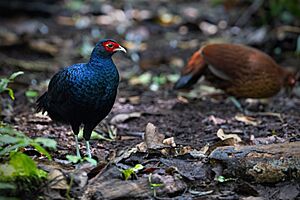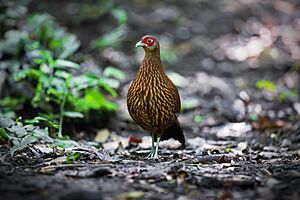Salvadori's pheasant facts for kids
Quick facts for kids Salvadori's pheasant |
|
|---|---|
 |
|
| Male | |
 |
|
| Female | |
| Conservation status | |
| Scientific classification | |
| Genus: |
Lophura
|
| Species: |
inornata
|
The Salvadori's pheasant (Lophura inornata) is a type of bird found in Indonesia. It lives in the mountain rainforests of Sumatra and is sometimes called the Sumatran pheasant. Some experts think the Hoogerwerf's pheasant is a type of Salvadori's pheasant.
An Italian bird expert named Tommaso Salvadori first described this bird in 1879. Its scientific name, inornata, means 'without ornament', which describes its plain look. Sadly, this pheasant is considered 'near threatened' by the IUCN. This is because its population is shrinking due to its home being destroyed and some hunting.
Contents
What Does the Salvadori's Pheasant Look Like?
Male and female Salvadori's pheasants look quite different from each other. The male bird looks a lot like the female crestless fireback (Lophura erythrophthalma).
Male Salvadori's Pheasant Appearance
The male Salvadori's pheasant is about 46 to 55 cm (18 to 22 in) long. It is mostly plain black. Its body and neck feathers have a bluish edge. The tail is short and rounded. Its beak is a whitish-green color, and its eyes have an orange-red center. Around its eye, there is a ring of bare skin that is yellowish-green or grey-green. The rest of the bare skin on its face is bright red. Its legs are greyish-blue and have a strong spur, which is a sharp growth.
Female Salvadori's Pheasant Appearance
The female is a bit shorter than the male and does not have a spur. Her feathers are reddish-brown. Each feather has tiny black spots and a pale stripe down the middle, making her look mottled or speckled. Her throat is a lighter brown, and her tail is blackish-brown.
Young Pheasant Appearance
Young pheasants look similar to the females. However, their feathers have pale buff edges, which gives them a scaled look.
How to Tell the Difference from a Crestless Fireback
There are a few main ways to tell a male Salvadori's pheasant apart from a female crestless fireback. The Salvadori's pheasant is longer and has a pale beak. It also tends to hold its tail down. The crestless fireback is sturdier, has a black beak, and usually holds its tail up. Also, Salvadori's pheasants live higher up in the mountains of Sumatra than crestless firebacks.
Where Do Salvadori's Pheasants Live?
The Salvadori's pheasant lives only in Sumatra, Indonesia. This means it is endemic to that island. You can find them in the mountains at heights between about 650 and 2,200 m (2,130 and 7,220 ft).
Different Types of Salvadori's Pheasants
There are two main types, or subspecies, of Salvadori's pheasant:
- L. i. inornata: This type is fairly common. It has been seen in many places in the middle and southern parts of the Barisan Mountains.
- L. i. hoogerwerfi: This type is also known as the Hoogerwerf's pheasant. It lives only in the northern part of the mountains and is seen less often.
Why is the Salvadori's Pheasant Near Threatened?
The International Union for Conservation of Nature (IUCN) has listed L. inornata as a "near-threatened species". This is because the total number of these birds is believed to be decreasing. Experts estimate there are only between five thousand and twenty thousand individuals left.
Threats to Their Survival
The main reasons their population is shrinking are:
- Habitat Loss: Their forest home is being cut down for illegal farming activities.
- Hunting: Some birds are hunted. A few have even been found for sale in local markets. The people selling them have said they were caught illegally from the Gunung Leuser National Park.


